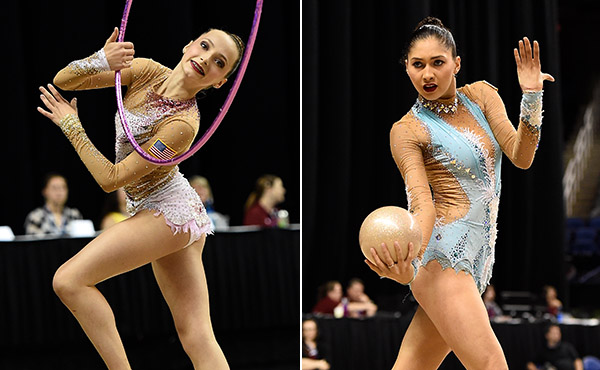
By John Powers
The breakthrough came at last September’s World Championships in Stuttgart where the United States qualified for this summer’s Olympics in individual and group rhythmic gymnastics without realizing it. “It was amazing,” says squad member Camilla Feeley, who’s competing in the Pacific Rim Championships presented by Hershey’s in Everett, Wash. “We knew it was definitely possible, but it was just so nice.”
Although Julie Zetlin represented the USA in London on a continental berth, it had been since 2003 that the Americans had earned an outright berth to the Games in individual rhythmic competition – Laura Zeng took care of that in Stuttgart. The U.S. never qualified on merit to the Olympics in group, having competing in Atlanta’s 1996 Games as the host country. The U.S. Group changed that last fall.
“It’s lifted the program across the board at all levels,” says rhythmic program director Caroline Hunt, who competed for the U.S. world team in the ’90s. “Athletes are inspired, coaches are inspired. It’s also an increased responsibility to prepare for the next level now that we’ve qualified. It’s a mix of real motivation, real inspiration and increased pressure and responsibility.”
The global breakthrough came after eight years of emphasis on improving coaching and technical fundamentals and building a deeper talent pool. “One of the traits of the women’s artistic program in this country is that they’re so competitive and they challenge each other to be better,” says Hunt. “And by creating more depth, we’re starting to see that with the rhythmic team.”
At last summer’s Pan American Games in Toronto the U.S. won the group silver medal behind Brazil, as Zeng claimed all five individual golds. This weekend in the Pac Rims at XFINITY Arena the hosts are favored to retain their title against challengers Canada and China. “Definitely gold,” says Aliya Protto, who collected two of each color at the 2014 event in British Columbia. “That’s what we’re going for.”
Just making the U.S. team this time was an achievement, with 14 candidates competing for five spots. “It was definitely more of a challenge,” says the 20-year-old Protto, who lives in Culver City, Calif., and attends Santa Monica College. “We have a lot of strong seniors and juniors who have moved up so it’s a bigger pool. So making it for this competition was definitely huge and an honor.”
Protto, who began as an artistic gymnast when she was 7, lasted just two days before she was told that she was too tall and switched over to rhythmic. “Our (club) program has changed tremendously since I was younger,” she says. “I look at the little girls who are at the lower levels and they’re doing stuff that was completely far beyond what we were doing when I was that age.”
Feeley, a 16-year-old who comes from Highland Park, Ill., belongs to the generation that started on the rhythmic side. “I love performing,” she says. “It’s so much fun with a crowd. It’s so beautiful when you can express to the music.”
“With our qualification to Rio, it has made everyone rise up to a higher standard so it’s made a huge difference for us,” says Protto. “It definitely boosts our confidence knowing that it’s possible for any of us to get to that level.”




